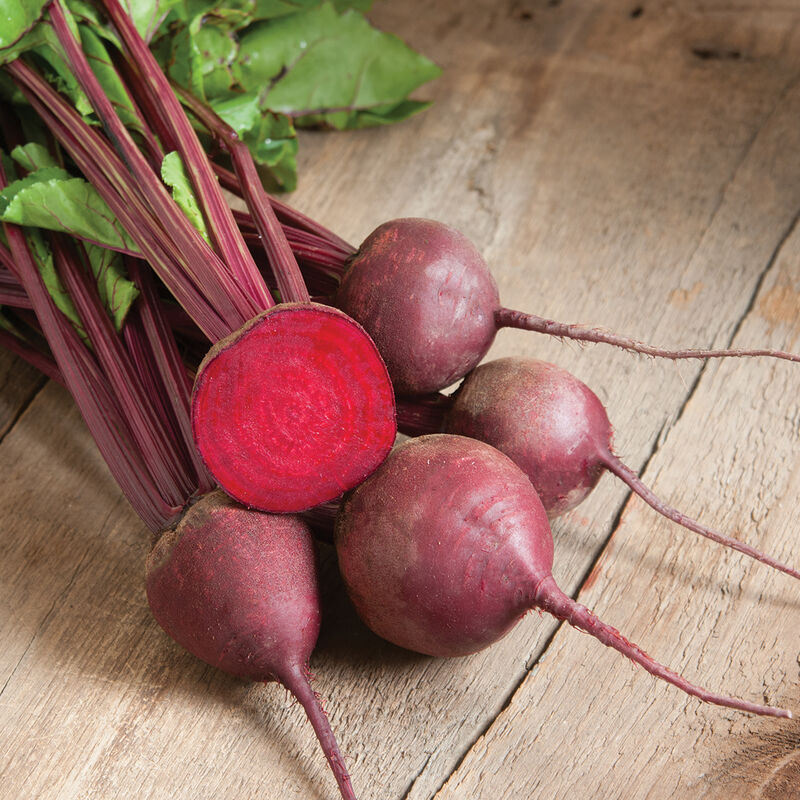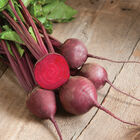Red Ace (F1) Beet Seed
Red Ace (F1) Beet Seed
Workhorse standard red beet.
A reliable and adaptable standard red beet. Medium-tall, red-veined greens for bunching. Less uniform and not as attractive as our other red hybrids. Also available with NOP-compliant pelleting.Specs:
- This product does not ship to the following countries: United Arab Emirates, Austria, Australia, Barbados, Belgium, Bulgaria, Bermuda, Bahamas, Switzerland, Cyprus, Czech Republic, Germany, Denmark, Estonia, Spain, Finland, France, United Kingdom, Greece, Hong Kong, Croatia, Hungary, Ireland, Iceland, Italy, Japan, Republic of Korea, Kuwait, Cayman Islands, Lithuania, Luxembourg, Latvia, Malta, Netherlands, Norway, New Zealand, Oman, Poland, Portugal, Qatar, Romania, Saudi Arabia, Sweden, Singapore, Slovenia, Slovakia, San Marino, Thailand, Trinidad and Tobago, Taiwan, Ukraine.
SCIENTIFIC NAME:
Beta vulgarisCULTURE:
First-rate crops grow quickly in light or loamy soils with a pH over 6.0. In general, cool temperatures produce the best flesh color. Acute weather fluctuations will cause zoning (white rings) in the roots.DIRECT SEEDING:
Begin early sowings when soil has warmed to 45°F (7°C). Sow 15 seeds/ft. 1/2" deep, rows 12–18" apart. Thin to 1 plant per 3". For a continuous supply of greens and small tender beets, sow seed at 2-week intervals until 8 weeks before regular heavy frosts are expected.TRANSPLANTING:
Sow seed in a cold frame or indoors in early spring, about 5-6 weeks before transplanting out after heavy frosts become infrequent. Sow 1/2" deep, 2–3 seeds per cell in 72- or 128-cell flats. Transplant 3" apart in rows 12–18" apart. Beets transplanted using this method may not be as uniform as direct-seeded beets, and taproots will tangle, requiring the harvester to gently pull out the root while holding back the rest. However, transplanted beets can bring earlier harvests if poor weather conditions persist and interfere with direct seeding.DISEASES:
Keep beets well-irrigated to prevent scab, the same disorder that affects potatoes, causing raised brown rough spots on the mature roots. Internal breakdown or browning is most likely to occur in alkaline soils after prolonged hot, dry periods. This is caused by a boron deficiency. Rotate crops to prevent Cercospora leaf spot, which is especially important for bunching and baby-leaf beets.HARVEST AND STORAGE:
Harvest when roots reach desired size, wash, and store bunches up to 10 days at 32°F (0°C) and 95% relative humidity.WINTER STORAGE OF ROOTS:
Sow about 8 weeks before heavy freeze is expected. Cut tops, wash, and store up to 6 months at 32°F (0°C) and 95% humidity.DAYS TO MATURITY:
From direct seeding; subtract 14–21 days if transplants are used.AVG. SEEDING RATE:
1M/66', 5M/333', 436M/acre at 15 seeds/ft. and 18" between rows.SIZED SEEDS:
"Sized" seeds have been sorted so they are roughly the same size. This consistency allows for more accurate spacing with mechanical seeders and more even germination. Beet seeds are sized, except when noted in the product description.SEED SPECS:
SEEDS/LB.: Avg. 37,000.PACKET:
350 seeds, sows 23'.Johnny's is committed to your success, every step of the way.
We want you, our customer, to be 100% satisfied with all of our seeds, tools, and supplies.
If anything you purchase from us proves unsatisfactory, we will either replace the item or refund the purchase price.




